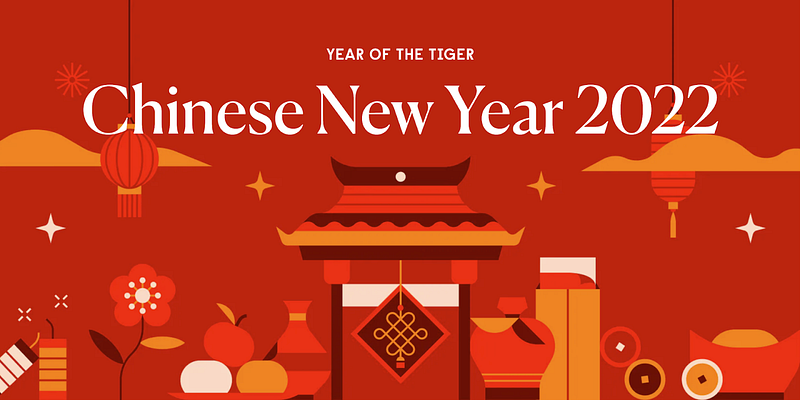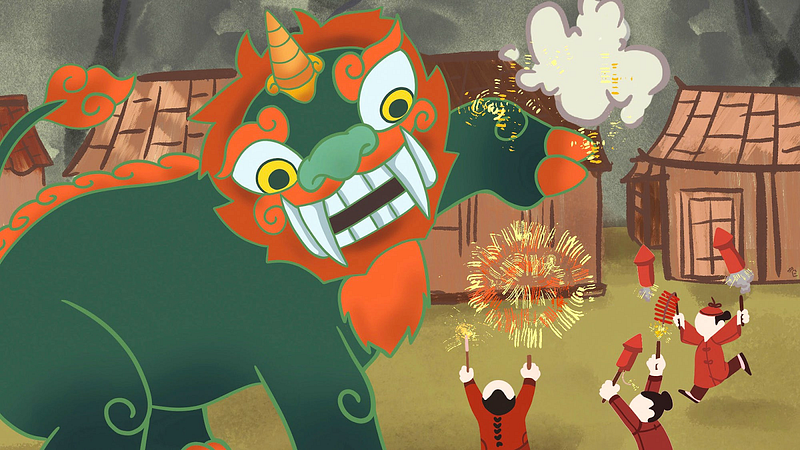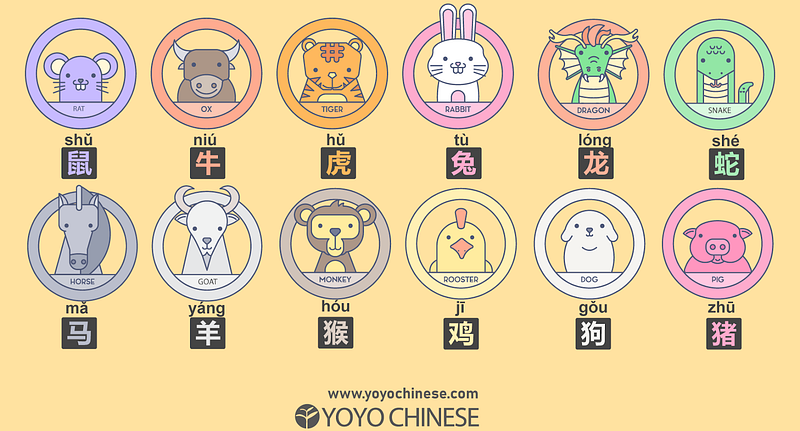The Meaning of Chinese New Year
Chinese New Year has been culturally significant since ancient times, when China was still an agrarian society. Farmers and workers who had…
Chinese New Year has been culturally significant since ancient times, when China was still an agrarian society. Farmers and workers who had not spoken to or met their families in a while could return back to their hometowns during this time to rest and reunite with their relatives after a year of long, hard labour to recharge for another (hopefully) fruitful year. Since people didn’t have the luxury of casually chatting up their loved ones behind small, portable screens back then — due to the fact that well, phones weren’t created yet — everyone in old-time China looked forward to Chinese New Year because it meant finally being able to reunite with the people they love to usher out the old year and to welcome in the new.
In today’s day and age, Chinese New Year is still an important event that brings families and friends together. In light of the struggles and hardships that many of us have faced and are still facing in the current pandemic, many have not had the liberty to go back to their hometowns and celebrate this festive season with their families for the past 2 years. During Chinese New Year, it is tradition to decorate your house bright red with lanterns and firecrackers, dazzling your visitors with a lion dance and gifting them with red envelopes known as “hong bao” (红包), but why? Continue reading to learn about Chinese New Year and discover more than what is simply on the surface of this beloved time of year.
The Legend Behind Chinese New Year
Legend has it that a long time ago, a beast called “Nian” terrorized villages on New Year’s Eve, attacking people, and eating livestock and children. To prevent the beast from committing such acts of destruction, people would put food at their doors as a sort of peace offering.
It is said that a wise old man figured out that Nian was scared of loud noises and the colour red, so people started putting red lanterns and red scrolls on their doors and windows to stop the Nian from coming inside. They also crackled bamboo (which was later replaced by firecrackers) to scare the mythical beast away. Their efforts weren’t in vain as the beast never showed up again.
The History of Chinese New Year
Chinese New Year, officially known as the Lunar New Year, dates back to about 3500 years. The exact date of its beginning though, is unconfirmed. However, according to most sources, this festival that is celebrated by most East Asians started back in the Shang Dynasty. To break it down for those who might not be familiar, the Lunar Calendar is an entirely separate calendar from the Gregorian Calendar (the one that is generally used by society today) and it can be traced back to 14th century B.C. It is believed that Emperor Huangdi, also the first Chinese emperor in 2637 B.C., invented this calendar according to the cycles of the moon. Interestingly enough, this Lunar New Year is not only celebrated by the Chinese, but also the Koreans, Vietnamese, Thai, Hong Kongese, Taiwanese, and the Japanese (sometime ago, but not anymore).
Just like technology, Chinese New Year too has seen major evolutions throughout 8 different dynasties. At the beginning, Chinese New Year was only celebrated to honour the Gods and Chinese ancestors by having sacrificial ceremonies. Following that, in the Han Dynasty was when the date for Chinese New Year was fixed, on the first day of the first month. Over the following years, more and more customs were added into the celebration of Chinese New Year including spring cleaning of houses, gathering of families and relatives, playing with firecrackers, traditional lion dances, and distribution of red envelopes.
Chinese Zodiac Animals
2022 marks the year of the tiger, but where exactly does the story of the Chinese Zodiac animals originate from? There are several variations of this story, but this is the version that is most commonly told. Once upon a time, the Jade Emperor planned to create the Chinese Zodiac because it was non-existent during his reign. The Jade sought 12 animals to serve as his guardians, so he dispatched an immortal creature into the world to spread the word about the Heavenly Gate race. The animals would be chosen in a race, which was designed to provide humans with a time measurement. There could only be 12 winners, and one of the challenges was to cross a fast-flowing river before reaching the finish line.
Rat got up early the next day and was first to reach the river, but he was unable to make it across due to the current. While waiting, Rat observed as Ox was about to cross the river and swiftly jumped into the Ox’s ear. Ox didn’t mind helping Rat and simply carried on. Rat won first and Ox came in second. Tiger and Rabbit came in third and fourth because both animals were swift and competitive, but Tiger beat Rabbit. Dragon came in fifth, which shocked many and even the emperor because he could fly. Dragon explained that on the way to the finishing line he had to stop by a few villages to help the people in need. Snake came in sixth place by claiming that Dragon was his adoptive father to the Jade Emperor. Then came Horse and Goat who treated each other with kindness and modesty. Their courtesy awed the emperor, who ranked them seventh and eighth. Monkey lagged behind but managed to catch up by hopping on trees and secured the ninth rank. Rooster, Dog and Pig were the last to arrive.
Interesting CNY Practices
Food
Dumplings
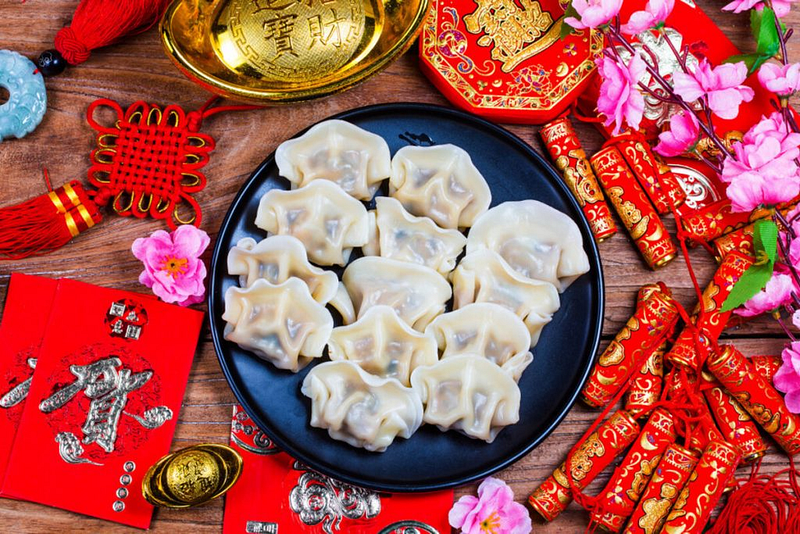
Dumplings are one of the most iconic and important courses of the Chinese New Year eve feast. Families will usually sit around the dinner table and wrap dumplings together in the afternoon on Spring Festival eve. Chinese people eat dumplings because their shape resembles the shape of ingots which were used as currency in ancient China, symbolising wealth and prosperity. There is a saying that the more dumplings one eats during the New Years, the more money they will make in the next year. So eat up!
2. Yee Sang (otherwise known as “Lou Sang”)
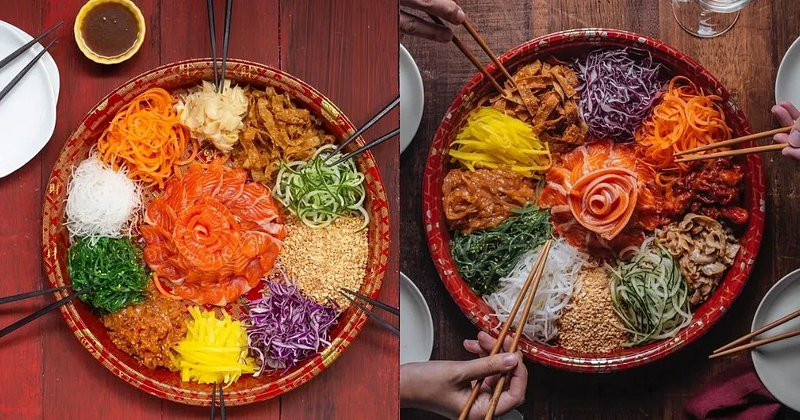
From the eve of Chinese New Year all up to Chap Goh Mei (the fifteenth day of CNY), a cantonese-style salad called “Lou Sang” (捞生) can be found at almost every table. As groups of families and friends “lou sang”, or toss the salad, they recite blessings and wishes of good luck and fortune that they wish to bring into the coming year.
Celebrations
Lion dance
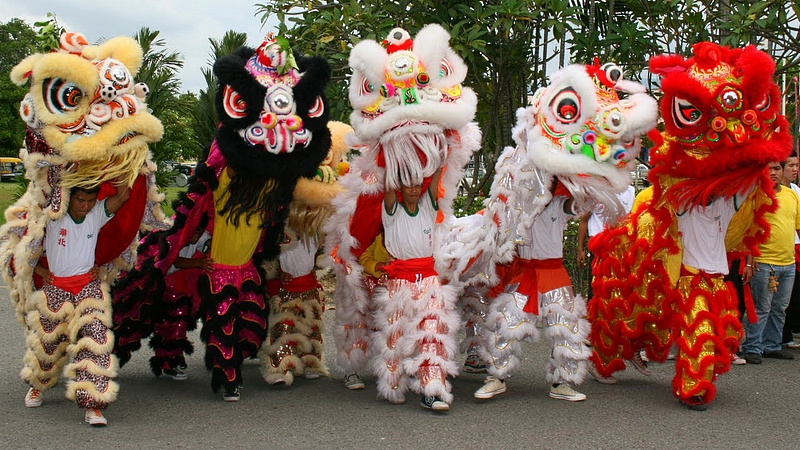
One of the most iconic Chinese New Year traditions is the lion dance. In Chinese culture, the lion symbolises wisdom, power and bravery. Apart from being performed to welcome prosperity and good luck into the new year, the lion dance is also said to be performed to chase away evil spirits, ghosts and monsters like Nian. Since those creatures are scared of loud noises, lion dance performances are often accompanied by firecrackers, clashing cymbals, a gong and drums. The lions are normally gifted with customary gifts like mandarins, oranges, and red envelopes that contain money.
Speaking of which, why does one of the most anticipated Chinese New Year traditions exist? Why do we give out red envelopes during this festival?
2. Red envelopes

The tradition of giving red envelopes actually originates from an old legend. On New Year’s Eve, a demon known as “Sui” would terrorize children as they slept. Parents would thus try to keep their children awake all night to protect them. One New Year, a child was given eight coins to play with to stay awake but he couldn’t keep his eyes open and eventually fell asleep with the coins on his pillow. The demon Sui appeared but as he went to touch the child, the coins, which were actually the legendary Chinese deities known as the Eight Immortals in disguise, produced a powerful light that drove the demon away. That’s also why in China, a red envelope is sometimes called “ya sui qian” (压岁钱), which translates to “suppressing Sui money”. Those who receive an envelope are wished another safe and peaceful year.
The real significance of giving red envelopes in the modern age is not the amount of money inside, but the red envelope itself. The colour red symbolises good luck and wealth in Chinese culture. So sending red packets shows that you want to pass off good luck, happiness and blessings to others.
3. Dragon dance

Another iconic tradition is the dragon dance, a tradition that has been practised since ancient times. Chinese dragons are a symbol of Chinese culture, symbolising wisdom, power and wealth. In the past, people performed the dragon dance to worship their ancestors, and during long periods of drought, to plead for enough rain for crops to survive, preventing sickness and hunger. Performing dragon dances after planting crops was also a way to pray against insect attacks.
There is a legend in the form of a fairy tale regarding dragons and their ability to bring rain in times of drought. One day, a long time ago, the Dragon King felt a terrible pain around his waist. Despite consuming all the medicine he could find, the pain still persisted. Not knowing what else to do, the Dragon King shifted into a human form and sought the advice of a human doctor.
After inspecting the Dragon King (in human form), the doctor realised that the being he was inspecting was not human and raised his concern with his patient. The Dragon King, unable to pretend anymore, shifted back to his original form. The doctor still helped to remove the pain by doing a small operation on the dragon’s waist and applying medication on the wound. The Dragon King, who felt better immediately, told the doctor in gratitude “dance in gears in the form of a dragon and you shall be granted with smooth weather and great harvests.” The news spread and thus began the tradition of people dancing in the gears and form of a dragon to plead for rain in seasons of drought.
In our times today, the dragon dance is performed during festive occasions as a means to chase away evil spirits and to bring good luck, welcoming in prosperous times. It is believed that the longer the dragon dances, the more luck it will bring to the community. It is also considered lucky if one is touched by the head of the dragon in the dance.
Traditions
Going Vegetarian on the first day

You might have known that some Chinese families go vegetarian on the first day of Chinese New Year, but do you know why? The tradition of adopting vegetarianism on the first day actually originates from Buddhism. Many Buddhists eat vegetarian food on the first day of Chinese New Year to pay respect to Buddha, in accordance with the Buddhist custom of commemorating the animals who offer their lives for our sustenance, and to gain good karma. However, in reality, this ritual is followed differently in different households and some households are stricter or more flexible than others.
Not cleaning the house on the first day
Most Chinese families practice not cleaning their house on the first day of CNY as it is believed that if one sweeps the floors or throws rubbish out of the house, one is sweeping and throwing away the good luck and wealth that one is blessed with on Chinese New Year. Most Chinese people also practise not washing their hair on the first day as doing so is believed to be equivalent to washing one’s luck away at the start of the New Year. This belief is also one of the reasons why Chinese families practise the ritual of spring cleaning before CNY, to drive away the bad luck (and dust) from the previous year to welcome a clean start.
Chinese New Year is a time that brings happiness and good fortune to everyone, whether they celebrate it or not. However, because of the Covid-19 pandemic, many people haven’t been allowed to see their families and friends in the last three years. The pandemic has been difficult for all of us, and it has taught us to value the limited time we have with each other, as well as the everyday moments and people we don’t want to take for granted. Hence, whenever the opportunity arises, we should treasure and enjoy the time we spend with our families and celebrate Chinese New Year with the core message of family, community, and connection at the forefront of our minds.
Written by: Ruby Seet and Balvin Dhaliwal. Edited by: Miza Alisya.


